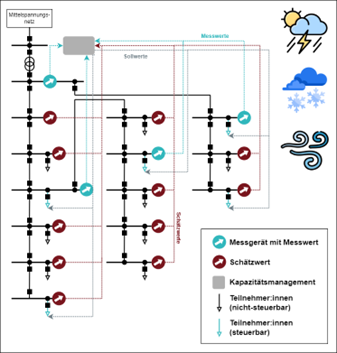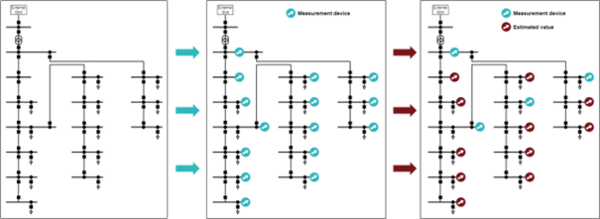Rising temperatures and cold spells due to climate change are increasing electricity demand for air conditioning and electric heating systems, putting additional strain on infrastructure through electrification and requiring efficient use of renewable energy. However, renewables are weather-dependent, posing challenges for energy infrastructure. Continuous monitoring of infrastructure, precise forecasting, and insights into flexibility are crucial.
INFRADAPT develops AI-based methods to optimize the capacities of low-voltage distribution networks. These methods consider the impacts of climate change on energy infrastructure and ensure fair distribution of capacities.
Efficient Measurement Infrastructure and Capacity Management
INFRADAPT is designed for real-time application and operates independently of network topology. The developed methods are technically and economically optimized to ensure efficient utilization of network resources. This includes optimal placement and sizing of the measurement infrastructure in low-voltage distribution networks. Additionally, a topology-independent capacity management system is being developed. It combines measurement data, AI-based estimation techniques, and AI-supported load flow methods to allocate existing network resources as needed and efficiently.
The Austrian Institute of Technology (AIT) leads this research project, contributing its domain expertise in scenario development and supporting the validation of the developed methods to ensure practical and future-proof solutions. The AIT Center for Energy develops algorithms to enhance the resilience of energy infrastructures, including optimal sensor placement and topology-independent capacity management for low-voltage networks. The AIT Center for Digital Safety and Security develops a secure and efficient data and communication concept.
Research Objectives
- AI-Based Network Optimization
- Develop methods for optimal utilization of network resources, considering the impacts of climate change.
- Enable precise network status estimation through optimally placed measurement infrastructure.
- Ensure fair resource utilization with topology-independent capacity management.
- Incorporation of Climate Scenarios
- Analyze climate scenarios to model generation and consumption profiles for normal and extreme conditions.
- Validate methods using Siemens' BIFROST simulation environment to account for climate-related influences.
- Data and Communication Concept
- Develop a robust data and communication concept for efficient network operation.
- Ensure fault tolerance and anomaly detection using AI-supported methods.
- Technical and Economic Validation
- Validate methods based on technical and economic criteria.
- Ensure real-time applicability, fairness, and compliance with network constraints.
- Conduct a cost-benefit analysis to guarantee economic viability
Funding
This project is funded by the Climate and Energy Fund and is being carried out as part of the “Energieforschung 2022” program.
![[Translate to English:] Power System Digitalisation Symbolfoto: Das AIT ist Österreichs größte außeruniversitäre Forschungseinrichtung](/fileadmin/_processed_/3/6/csm_BWO-2019-06-19-AIT-0023__web_header_9c7b38a01c.jpg)





